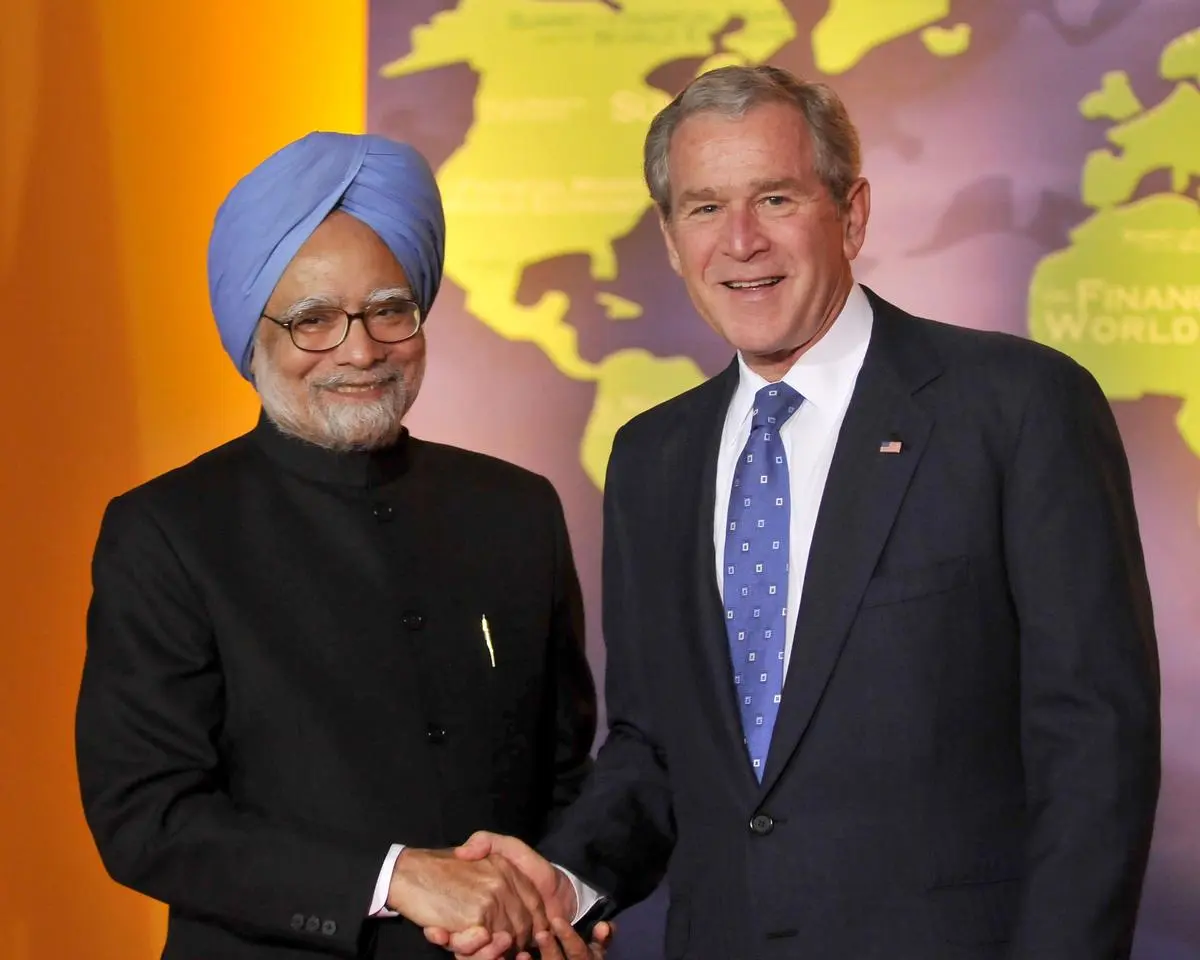How ‘weak’ Manmohan Singh confirmed shocking resilience to seal Indo-US nuclear deal
The previous Prime Minister, who turns 91 on September 26, outwitted each political allies and rivals to assist finish India’s “nuclear apartheid”.
India’s Prime Ministers have taken choices that modified the course of the nation’s historical past. Neerja Chowdhury, an award-winning journalist and political commentator, goes past the information headlines to supply an eye-opening account of how among the most vital political choices in impartial India have been taken.
In How Prime Ministers Resolve, the writer analyses the working types of six of the nation’s Prime Ministers by means of the prism of six choices of historic significance. Based mostly on a whole lot of interviews that the writer carried out with prime ministers, key figures within the political institution, bureaucrats, aides, policymakers, and even fixers—the e-book gives outstanding insights which have been gleaned over forty years of high-level reporting on the nationwide political scene.
Within the remaining chapter of the e-book, Chowdhury writes about how the gentle and professorial Manmohan Singh, broadly thought to be one of many nation’s weakest Prime Ministers, defied curiosity teams and foes throughout the political institution to seal a historic nuclear cope with america—and upgraded the bilateral relationship to a brand new stage. The next is an excerpt from the stated chapter.
*******
When Manmohan Singh turned prime minister, the person he usually turned to for assist was CPI(M) common secretary Harkishan Singh Surjeet—regardless of the variations the PM had with the communists. Manmohan Singh had needed Montek Singh Ahluwalia as finance minister. However Sonia Gandhi dominated that out—and chosen P. Chidambaram as a substitute.
The resourceful Surjeet helped Manmohan Singh. Ahluwalia turned deputy chairman of the Planning Fee and was given cupboard rank. Consequently, he might attend cupboard conferences—and be the PM’s eyes and ears. Given his proximity to the PM, there can be extra vehicles of politicians and diplomats parked outdoors Yojana Bhavan than outdoors the PM’s residence.
Additionally Learn | Congress: Classes from historical past
Earlier than he took over as deputy chairman of the Planning Fee, Ahluwalia requested the PM if there was anybody specifically he needed him to fulfill. Manmohan Singh informed him to name on Surjeet. Ahluwalia met the eighty-eight-year previous Comrade Surjeet who ‘supplied me tea and biscuits’—not ‘disapproval’. The CPI(M) leaders weren’t pleased with the appointment of Ahluwalia who had held a place within the IMF. They’d requested Surjeet to intervene and cease it however by then it was too late.
The Congress leaders additionally seemed askance at Ahluwalia’s appointment and would joke in regards to the ‘Sardar to Sardar’ bonhomie which had swung the appointment. All three—Manmohan Singh, Montek Singh Ahluwalia, and Harkishan Singh Surjeet—have been Bhapa Sikhs, they might say snidely. The Ahluwalias, Montek and his eminent economist spouse Isher Decide Ahluwalia, have been long-time private mates of Manmohan Singh and his spouse Gursharan Kaur.
Manmohan Singh’s troubles with the Left began the second Prakash Karat (in image) turned common secretary of the CPI(M). Karat was particularly tough to cope with on the Indo–US strategic relationship.
| Picture Credit score:
MUSTAFAH Okay.Okay.
Manmohan Singh’s troubles with the Left began the second Prakash Karat changed Harkishan Singh Surjeet as common secretary of the CPI(M). Surjeet and Jyoti Basu, former chief minister of West Bengal, each high leaders of the CPI(M), had repeatedly assured Manmohan Singh of their help when he turned PM in 2004. He would don’t have any hassle from them, they might say—so long as the Congress adhered to the Frequent Minimal Programme.
After Surjeet stepped down from the management of the CPI(M), Karat was a thorn within the PM’s facet. Whereas Karat’s public persona was that of an ideologically unyielding robust negotiator, in individual he was light—and a radical gentleman. Karat was particularly tough to cope with on the Indo–US strategic relationship. Congress leaders discovered him the hardest nut to crack.
***
Within the 2009 elections, the Congress Occasion got here again to energy with an elevated majority. Guaranteeing the ‘Proper to Work’ and a mortgage waiver to farmers value Rs.75,000 crores had helped it beat again the anti-incumbency towards the federal government. It managed to get 206 seats within the Lok Sabha, growing its 2004 tally by 61 seats.
The Indo–US nuclear deal was not a problem within the polls which attracted voters. Few understood—or cared about it. However city Indians accepted of the way in which by which it had introduced India nearer to the US, which was a vacation spot for a lot of Indians. Manmohan Singh, who would go on to go the UPA for 5 extra years, was admired for the way in which by which he had resolutely pursued the deal. His dealing with of the worldwide monetary disaster of 2007–09, and the speedy progress of the economic system since 2004, had are available for acclaim by center class Indians who had made good.
Manmohan Singh with US President George W. Bush. The resourcefulness, tenacity, and willpower Singh displayed in pursuing the Indo–US Civil Nuclear Deal revealed a brand new facet to him.
| Picture Credit score:
RON SACHS/Bloomberg Information
Electoral implications aside, the Indo–US Civil Nuclear Deal ended the ‘nuclear apartheid’ India had been subjected to for thirty years. There weren’t simply the restrictions on nuclear commerce globally but in addition the ‘technological apartheid’ which had kicked into place on account of sanctions. The deal enabled India to purchase gasoline, reactors, gear, and know-how from different nations. There was a scarcity of uranium within the nation and most of the nuclear reactors have been operating at 40-55 per cent capability. The opening up of nuclear commerce helped India stockpile uranium for every of the civilian reactors that have been put below the IAEA’s safeguards.
After the deal, India has been capable of purchase uranium from Russia, Canada, Kazakhstan, and different nations. In accordance with the scientists, this has made the state of affairs comfy for India’s nuclear programme, each civilian and strategic.
***
Manmohan Singh’s authorities was not like another that existed earlier than or after. No full-term, quite two-term, prime minister was as hemmed in as he was. Sonia Gandhi took the political choices and had a say in main coverage initiatives. The PM let Pranab Mukherjee, one other highly effective determine within the authorities, run a lot of the administration by means of key decision-making our bodies like scores of GOMs. Consequently, Manmohan Singh’s authority was severely curtailed, and he labored below constraints.
Might Manmohan Singh have asserted himself extra as prime minister even if he owed his place to Sonia Gandhi, and the mannequin of coalition that known as for energy sharing together with her? For Sonia wanted him as a lot as he wanted her.
That nevertheless was not his persona. He most popular to be a blade of grass which bends when the storm comes, quite than the tree which stands up straight and falls. That’s the reason he lasted for ten years. However within the course of, the authority of the prime minister took a beating—and although upright and honest, he was seen as among the many weak prime ministers India has had. And but, the resourcefulness, tenacity, and willpower Manmohan Singh displayed in pursuing the Indo–US Civil Nuclear Deal revealed a brand new facet to him.
Additionally Learn | Complicated file
Over the greater than three years it took to conclude the deal, he displayed traits and political savvy that few imagined he possessed. He took on formidable opponents throughout the political spectrum—and managed to finest them, or win them over to his facet. He took huge dangers, placing his authorities in jeopardy, confirmed an understanding of the political system in India, displayed a eager information of geopolitics and international coverage—and demonstrated that he might get his manner. This underrated prime minister managed to tug off the unlikeliest of triumphs.
Excerpted with permission of Aleph Guide Firm from How Prime Ministers Resolve by Neerja Chowdhury.






